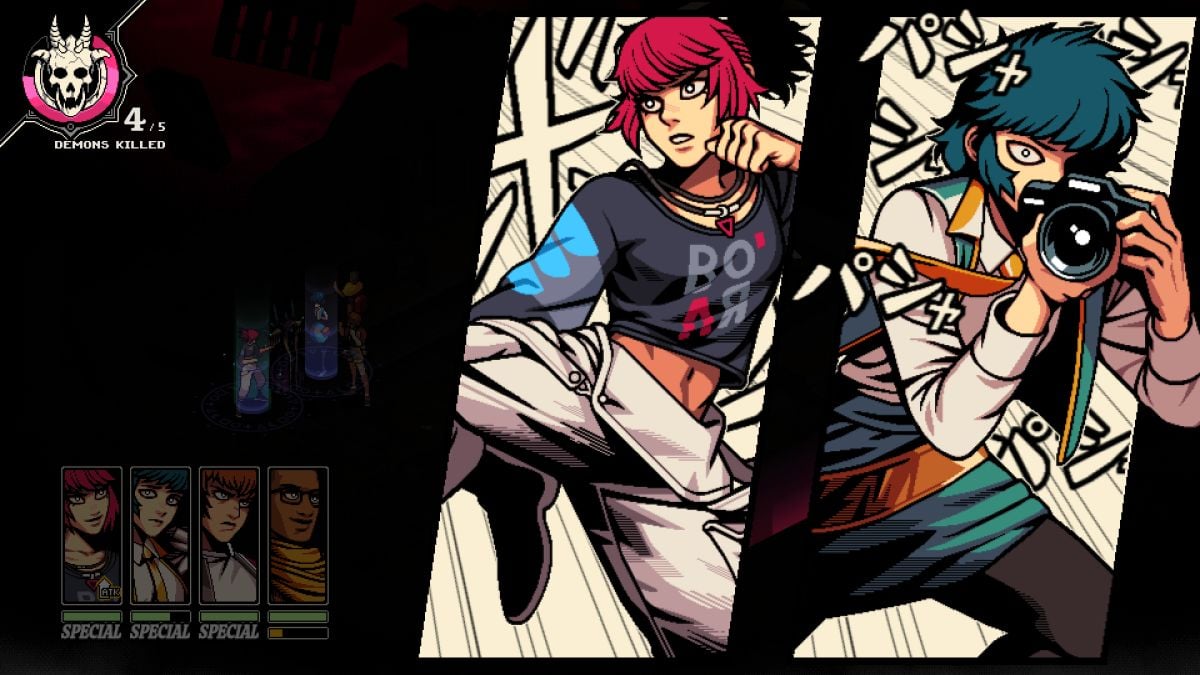Class is in
A game like Demonschool feels like the kind of mash-up that makes obvious sense in hindsight. Tactics games are quite popular, as are their often-accompanying social mechanics and life-sim elements. So combining demons and school makes sense.
But Demonschool is a lot more than the sum of its parts. It’s a sleek, engaging tactics game that gets right to the thick of things. It’s a school life sim that easily slots into the overall drives of the story. And it’s a game I’ve been thinking a lot about since my two playthroughs at PAX East 2023.
Demonschool follows Faye, the last in a family line of demon hunters, attending an island university. Joined by photo-nerd Namako, the cheery Knute, and high-octane himbo Destin, some occult and demonic mishaps soon occur, and the crew has to get to the bottom of it with their wits and fists.
University life
During normal hours, the crew can venture around, taking on a variety of tasks and side quests. A few of them weren’t available in the demo, but others allowed you to learn more about the island and its inhabitants, or just get a little slice of the university life. (Note: This is a college, not the high school fare you usually see in school-life stories, which I dug.) One of my favorite side stories simply led to discovering that Destin, who asked for help in figuring out why his milk tasted weird, had been drinking spoiled milk for a long time and grown accustomed to the taste and chunks.
Nice slice-of-life aside, this is also where the style of Demonschool shined bright. Recent hits like Signalis and Neon White have done a lot with sheer style in their UI and menu design, and Demonschool slots neatly into that subgenre of sleek, gorgeous, text-infused canvasses for otherwise routine activities.
Suffice to say, Demonschool already has an extremely compelling art style. The writing is solid too, creating natural ups and downs of drama while also letting the misfits act like, well, misfits. The four party members are a good mix of personalities, and I’m interested to see more, as there are 15 planned party members for Demonschool.
All of the out-of-combat stuff works great, engaging with plenty of lighthearted story beats while also dipping into interesting topics surrounding the otherworldly occurrences on the island. And when the battles kick off, it veers into a different but just-as-good dynamic.
Tile warfare
One of my favorite parts about Demonschool is how straightforward its combat system is. Each of your members can move and act for an action, which takes up one dot of your action bar. Those movements and strikes are, unless otherwise noted, placed along the straights and diagonals of the grid. Leaping across the field and punching someone is as easy as selecting a character, moving the cursor over, and executing; no menus or commands required.
From here, extra considerations get added on. Knute heals allies, for example, or gives them an attack buff if they’re at full health. Namako hops enemies, like in checkers, stunning them as she does so. Attacks can knock enemies into each other like Into the Breach for added damage. And striking an enemy from opposing sides with your characters can create a combo, complete with a portrait cut-in and special effects.
Each successive action costs more, though. Faye might be a heavy hitter, but a second move will cost two dots, and a third three, and so on. Much like Valkyria Chronicles paces out the number of times a unit can take successive action, so does Demonschool. And the enemies are no slouches either. Turns take place out of time, with you planning and then executing your actions with perfect knowledge of the incoming enemy behaviors. In turn, a hit from one enemy can do some decent damage, or even fully take out a team member.
It all becomes a careful game of back and forth on the tiles, as you measure resources and potential board clear states against ever-increasing numbers. There’s always the threat of escaping foes, too; a certain enemy type, which crawls slowly but surely towards your side of the tile board, can rip open a tear in the battlefield. If they manage to get through, that’s an instant game over. No letting demons run amok.
Hell let loose
While beating up demons and the mob is one thing, fighting a giant skeleton with a huge brain is a different challenge. While the story demo gave a taste of all the above, through the mix of life sim and tactical combat, the boss demo put a challenge forward. Here, the Demonschool crew takes on a massive foe threatening the island, and it’s not easy.
The fight was a constant back-and-forth as enemy waves kept spawning, and the boss kept unleashing massive, row-clearing moves on the board. It was chaos, soaked in a mix of both Japanese horror manga and Italian horror vibes. While life sim might make you think of Persona, the overall tone of Demonschool had me leaning much more towards Shin Megami Tensei and its own tactics spin-off, Devil Survivor.
This boss fight showed just how much potential there was in Demonschool‘s combat system, which simplified in the right places but still allowed for player expression and rewarded clever adaptation to new problems. Between the look, sound, style, writing, and fighting of Demonschool, I’m very interested in seeing what Necrosoft has planned for its eventual launch.
For all the latest Gaming News Click Here
For the latest news and updates, follow us on Google News.

